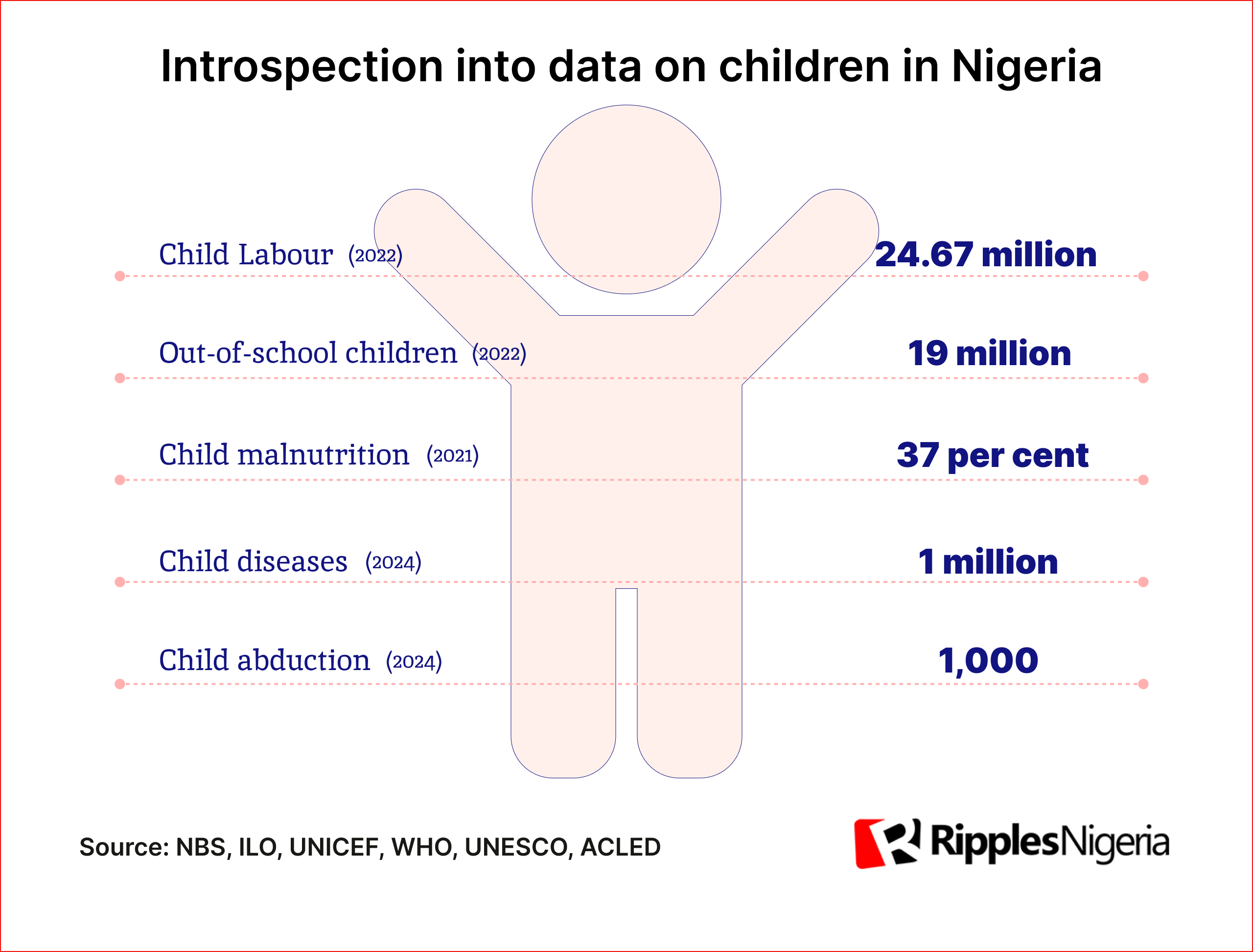Ripples Metrics
RipplesMetrics: How data shows challenges of children living in Nigeria

A 2022 Nigeria’s Child Labour report showed that four out of every 10 children who reside in Nigeria are engaged in some form of labour that is essentially exploitative or injurious.
The report which was published by the National Bureau of Statistics in collaboration with the International Labour Organization and the Federal Ministry of Labour and Employment showed that at least 24.67 million out of 62.90 million children are in child labour between ages five and 17.
Breaking down by age group, 14.99 million children (60.8 per cent) are in the 5-11 age group, 5.12 million children (20.8 per cent) are in the 12-14 age group and 4.5 million children (18.4 per cent) are in the 15-17 age group.
The survey revealed that 39.6 per cent of boys were in child labour than girls which is 38.8 per cent. Also, child labour is more predominant in rural areas with 44.8 per cent than in urban areas with 30 per cent.
Furthermore, 31.77 million children between the overall age group of 5-17 years old are engaged in economic activity while 14.39 million children are involved in hazardous work.
The survey also showed that a larger proportion of children are working only, representing 21.9 per cent. Meanwhile, only 24.7 per cent are exclusively in school and 45.3 per cent are working and in school simultaneously.
The South-East and North-East regions, the report noted, were experiencing the highest incidence of child labour, with 49.9 per cent and 49.4 per cent, respectively. However, the states with the highest child labour were Cross River (67.4 per cent), Yobe (62.6 per cent), Abia (60.1 per cent) and Plateau (58.9 per cent).
Comparison with other child-related data
The 2022 data on child labour represents 39.23 per cent of the child population. This is a drop from 51 per cent reported in 2018. However, despite the drop, there are concerns over the growing challenges for children living in Nigeria, from insecurity which has displaced millions of children to health-related diseases which are threatening children’s lives.
Here are some figures:
The International Displacement Monitoring Centre (IDMC) said that over a million internally displaced children who are within schooling age in Nigeria do not have access to quality education.
Moreso, UNSECO reported that over 19 million children in Nigeria have been reported as out-of-school children with a majority of these affected children in the Northern region. Also, in the last decade, more than 1000 school children have been kidnapped in more than 10 states.
Another UNICEF data says that about 7.6 million girls in Nigeria are not enrolled in school, while 70 per cent of children in Nigeria cannot read with meaning or solve simple math problems.
The World Health Organization, in 2023, ranked Nigeria as the country with the second highest number of maternal, neonatal and child
deaths worldwide. For child malnutrition, 37 per cent of children living in Nigeria were stunted as of 2021.
Recently, the Coordinating Minister of Health and Social Welfare, Ali Muhammad Pate, said one million children under five years old die every year in Nigeria from diseases, including vaccine-preventable ailments. Pate, however, said that President Bola Ahmed Tinubu’s government targeted policies that would directly touch the lives of the masses, adding that investment in the health sector was one of them.
By: James Odunayo
Join the conversation
Support Ripples Nigeria, hold up solutions journalism
Balanced, fearless journalism driven by data comes at huge financial costs.
As a media platform, we hold leadership accountable and will not trade the right to press freedom and free speech for a piece of cake.
If you like what we do, and are ready to uphold solutions journalism, kindly donate to the Ripples Nigeria cause.
Your support would help to ensure that citizens and institutions continue to have free access to credible and reliable information for societal development.
























